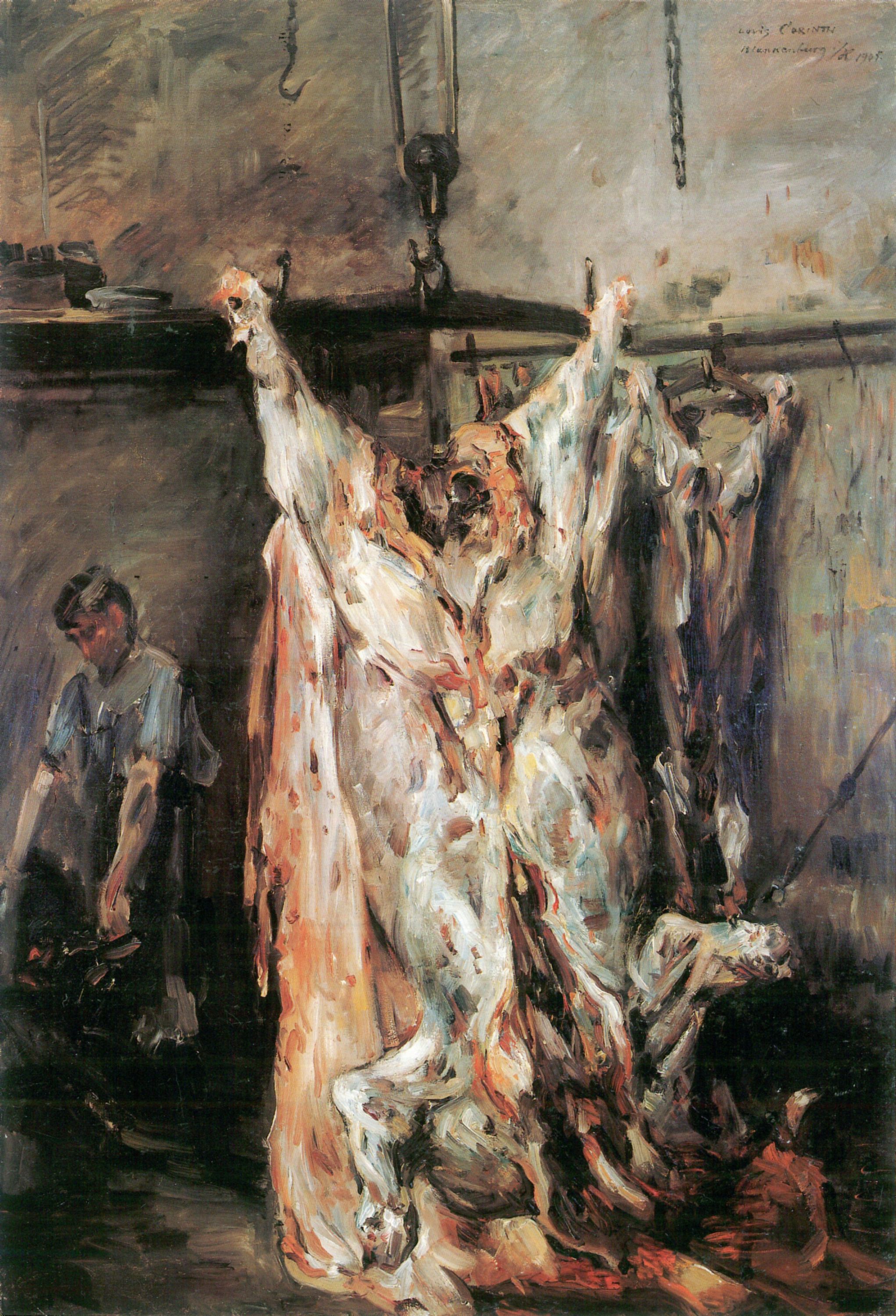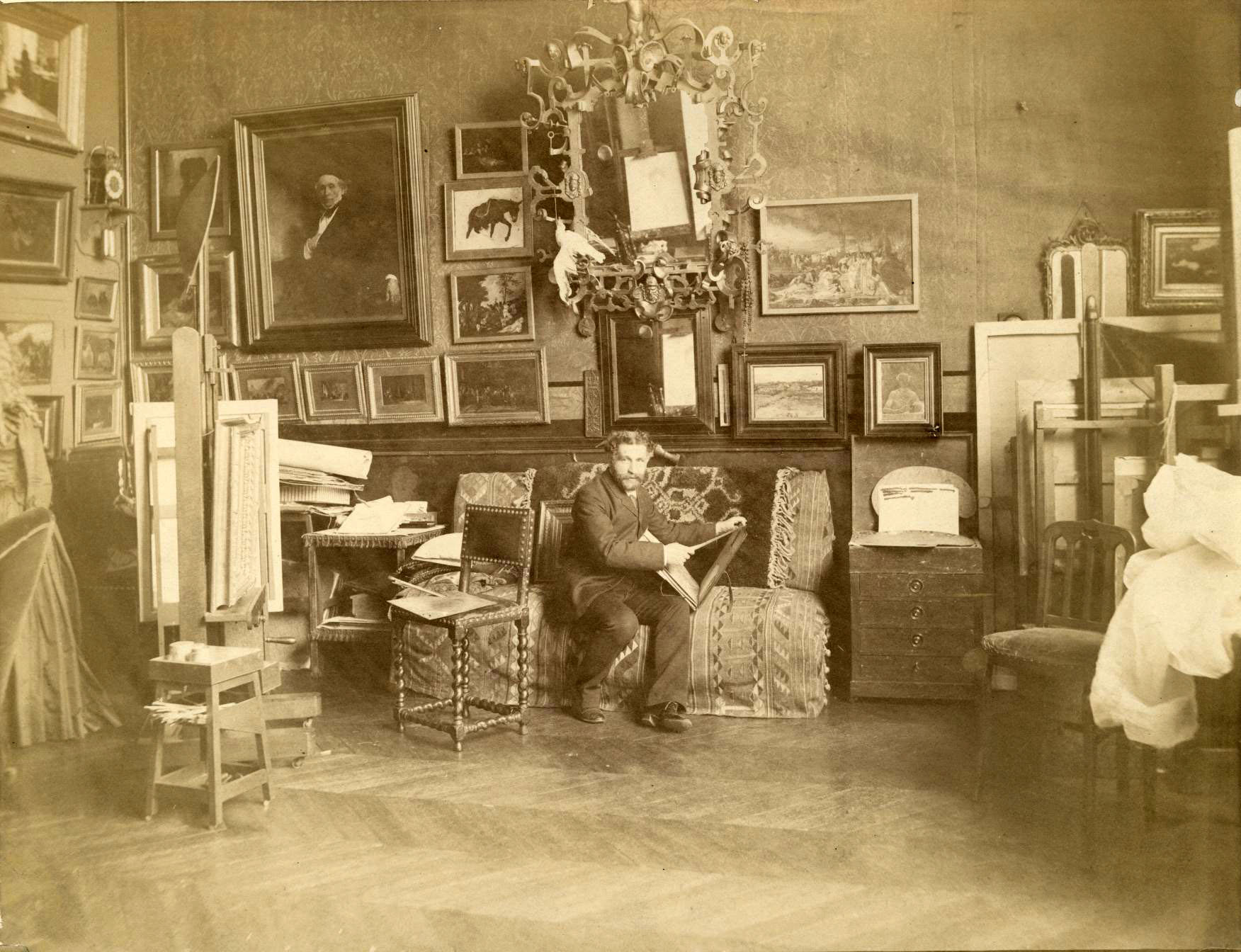|
Lovis Corinth
Lovis Corinth (21 July 1858 – 17 July 1925) was a German artist and writer whose mature work as a painter and printmaker realized a synthesis of impressionism and expressionism. Corinth studied in Paris and Munich, joined the Berlin Secession group, later succeeding Max Liebermann as the group's president. His early work was naturalistic in approach. Corinth was initially antagonistic towards the expressionist movement, but after a stroke in 1911 his style loosened and took on many expressionistic qualities. His use of color became more vibrant, and he created portraits and landscapes of extraordinary vitality and power. Corinth's subject matter also included nudes and biblical scenes. Early life Corinth was born Franz Heinrich Louis on 21 July 1858 in Tapiau, in the Province of Prussia in the Kingdom of Prussia. The son of a tanner, he displayed a talent for drawing as a child. In 1876 he went to study painting in the academy of Königsberg. Initially intending to become a ... [...More Info...] [...Related Items...] OR: [Wikipedia] [Google] [Baidu] |
Gvardeysk
Gvardeysk ( rus, Гвардейск, p=ɡvɐrˈdʲejsk, a=Ru-Гвардейск.oga; known prior to 1946 by its German name Tapiau ; ; ), is a town and the administrative center of Gvardeysky District in Kaliningrad Oblast, Russia, located on the right bank of the Pregolya River east of Kaliningrad. Population figures: It is located within the historic region of Sambia. History Peter of Dusburg wrote of a settlement known as Tapiow, first documented in 1254, and the neighboring fort ''Surgurbi'' built by 1265.Oesterley, p. 676 The Old Prussian names were derived from the words , , , , meaning 'warm', and , meaning 'around the mountain'. During the 13th century Prussian Crusade, the area was conquered by the Teutonic Knights. To protect Samland from the Nadruvians and Scalvians, the crusaders built a wooden fort between the Deime and Pregel Rivers in 1283–1290. This was replaced by Tapiau Castle, a stone Ordensburg, in 1351. The settlement gradually became know ... [...More Info...] [...Related Items...] OR: [Wikipedia] [Google] [Baidu] |
Franz Von Defregger
Franz Defregger (after 1883 Franz von Defregger) (30 April 1835 – 2 January 1921) was an Austrian artist known for producing genre art and history paintings set in his native county of Tyrol. Biography Franz Defregger was born on 30 April 1835 at the Ederhof in Stronach, Tyrol in the Austrian Empire. He was the second son of Maria (née Fercher) and Michael Defregger, a farmer, who also had five daughters. His mother and two of his sisters died in 1841 during a typhoid epidemic. Franz himself nearly died from the fever. During his early years, Franz developed a strong love of music, and learned to play the flugelhorn. He soon became a member of a local band in Dölsach, playing at weddings, assemblies, and balls. Franz also displayed an early talent for drawing and woodcarving, which he developed autodidactically while working on his father's farm. After his father died in 1858, Franz took over the farm at the age of twenty-three. Within two years, however, he sold the farm ... [...More Info...] [...Related Items...] OR: [Wikipedia] [Google] [Baidu] |
Lovis Corinth Schlachterladen 1897
Lovis can be a given name and a surname: ;Given name * Lovis Corinth (1858-1925), German painter * (1898-1976), German publisher, writer and journalist ;Surname * , Swiss astronomer * (1817–1890), Swiss architect See also * Lovi (other) Lovi may refer to: * George Lovi (1939–1993), Hungarian-American astronomical cartographer * 5943 Lovi a main-belt asteroid, named after George Lovi * Lovi Poe (born 1989), a Filipino actress and model See also * Lovie (name) * Lovin (surna ... * Lovisa (given name) {{given name, type=both ... [...More Info...] [...Related Items...] OR: [Wikipedia] [Google] [Baidu] |
Paris Salon
The Salon (), or rarely Paris Salon (French: ''Salon de Paris'' ), beginning in 1667 was the official art exhibition of the in Paris. Between 1748 and 1890 it was arguably the greatest annual or biennial art event in the Western world. At the Salon of 1761, thirty-three painters, nine sculptors, and eleven engravers contributed. Levey, Michael. (1993) ''Painting and sculpture in France 1700–1789''. New Haven: Yale University Press, p. 3. From 1881 onward, it was managed by the Société des Artistes Français. Origins In 1667, the royally sanctioned French institution of art patronage, the (a division of the Académie des beaux-arts), held its first semi-public art exhibit at the Salon Carré. The Salon's original focus was the display of the work of recent graduates of the École des Beaux-Arts, which was created by Cardinal Mazarin, chief minister of France, in 1648. Exhibition at the Salon de Paris was essential for any artist to achieve success in France for at le ... [...More Info...] [...Related Items...] OR: [Wikipedia] [Google] [Baidu] |
Académie Julian
The () was a private art school for painting and sculpture founded in Paris, France, in 1867 by French painter and teacher Rodolphe Julian (1839–1907). The school was active from 1868 through 1968. It remained famous for the number and quality of artists who attended during a great period of effervescence in the arts in the early twentieth century. After 1968, it integrated with the École supérieure de design, d'art graphique et d'architecture intérieure (ESAG) Penninghen. History Rodolphe Julian established the Académie Julian in 1868 at the Passage des Panoramas, as a private studio school for art students.Tate Gallery"Académie Julian."/ref> The Académie Julian not only prepared students for the exams at the prestigious École des Beaux-Arts, but offered independent alternative education and training in arts. "Founded at a time when art was about to undergo a long series of crucial mutations, the Academie Julian played host to painters and sculptors of every kind ... [...More Info...] [...Related Items...] OR: [Wikipedia] [Google] [Baidu] |
Tony Robert-Fleury
Tony Robert-Fleury (1 September 18378 December 1911) was a French painter, known primarily for historical scenes. He was also a prominent art teacher, with many famous artists among his students. Biography He was born just outside Paris, and studied under his father Joseph-Nicolas Robert-Fleury and under Paul Delaroche and Léon Cogniet at the École des Beaux-Arts (School of Fine Arts) in Paris. His first painting at the Salon de Paris, in 1866, was a large historical canvas, titled ''Varsovie, Scène de l'Insurrection Polonaise'', recalling the events of 8 April 1861 in Warsaw, when Russian troops quenched riots by force. In the following year, his "Old Women in the Place Navone, Rome" was purchased by the Musée du Luxembourg. In 1870, he painted a canvas of ''Le Dernier Jour de Corinthe'' (''Last Day of Corinth''), which depicted the last day before the Roman legions looted and burned the ancient Greek city, according to Livy. This painting was also purchased by the Mus ... [...More Info...] [...Related Items...] OR: [Wikipedia] [Google] [Baidu] |
William-Adolphe Bouguereau
William-Adolphe Bouguereau (; 30 November 1825 – 19 August 1905) was a French Academic art, academic painter. In his realistic genre paintings, he used mythological themes, making modern interpretations of Classicism, classical subjects, with an emphasis on the female human body. During his life, he enjoyed significant popularity in France and the United States, was given numerous official honors, and received top prices for his work. As the quintessential salon painter of his generation, he was reviled by the Impressionism, Impressionist avant-garde. By the early twentieth century, Bouguereau and his art fell out of favor with the public, due in part to changing tastes. In the 1980s, a revival of interest in figure painting led to a rediscovery of Bouguereau and his work. He finished 822 known paintings, but the whereabouts of many are Lost artworks, still unknown. Life and career Formative years William-Adolphe Bouguereau was born in La Rochelle, France, on 30 November 1825, ... [...More Info...] [...Related Items...] OR: [Wikipedia] [Google] [Baidu] |
Peter Paul Rubens
Sir Peter Paul Rubens ( ; ; 28 June 1577 – 30 May 1640) was a Flemish painting, Flemish artist and diplomat. He is considered the most influential artist of the Flemish Baroque painting, Flemish Baroque tradition. Rubens' highly charged compositions reference erudite aspects of classical and Christian history. His unique and immensely popular Baroque style emphasised movement, colour, and sensuality, which followed the immediate, dramatic artistic style promoted in the Counter-Reformation. Rubens was a painter producing altarpieces, portraits, landscapes, and history paintings of mythological and allegorical subjects. He was also a prolific designer of cartoons for the Flemish tapestry workshops and of Book frontispiece, frontispieces for the publishers in Antwerp. Rubens was born and raised in the Holy Roman Empire (modern-day Germany) to parents who were refugees from Antwerp in the Duchy of Brabant in the Southern Netherlands (modern-day Belgium) and moved to Antwerp at ab ... [...More Info...] [...Related Items...] OR: [Wikipedia] [Google] [Baidu] |
Wilhelm Trübner
Wilhelm Trübner (February 3, 1851 – December 21, 1917) was a German Realism (visual arts), realist Painting, painter of the circle of Wilhelm Leibl. Biography Trübner was born in Heidelberg. He was the third son of a silver- and goldsmith, Johann Georg Trübner, and his wife Anna Maria.Bahns et al. 1994, p. 73. In 1867 he began training as a goldsmith in Hanau, and met Classicism, classicist painter Anselm Feuerbach who encouraged him to study painting. In that year he began studies at the Kunstschule in Karlsruhe under Karl Friedrich Schick. He was influenced by artists he met in Karlsruhe, such as Hans Canon and Feodor Dietz.Ruhmer, E. (2003, January 01). "Trübner, (Heinrich) Wilhelm". Grove Art Online. In 1869 he began studying at the Kunstacademie in Munich, where he was greatly impressed by an international exhibition of paintings by Leibl and Gustave Courbet. Courbet visited Munich in 1869, not only exhibiting his work but demonstrating his alla prima method of wo ... [...More Info...] [...Related Items...] OR: [Wikipedia] [Google] [Baidu] |
Wilhelm Leibl
Wilhelm Maria Hubertus Leibl (October 23, 1844 – December 4, 1900) was a German realist painter of portraits and scenes of peasant life. Biography Leibl was born in Cologne, where his father was the director of the Cathedral choir. He was apprenticed to a locksmith before beginning his artistic training with the local painter Hermann Becker in 1861. He entered the Munich Academy in 1864, subsequently studying with several artists including Carl Theodor von Piloty. He set up a group studio in 1869, with Johann Sperl, Theodor Alt, and Rudolf Hirth du Frênes. At about the same time, Gustave Courbet visited Munich to exhibit his work, making a considerable impression on many of the local artists by his demonstrations of alla prima painting directly from nature. Leibl's paintings, which already reflected his admiration for the Dutch old masters, became looser in style, their subjects rendered with thickly brushed paint against dark backgrounds. Career In 1869, following Co ... [...More Info...] [...Related Items...] OR: [Wikipedia] [Google] [Baidu] |






